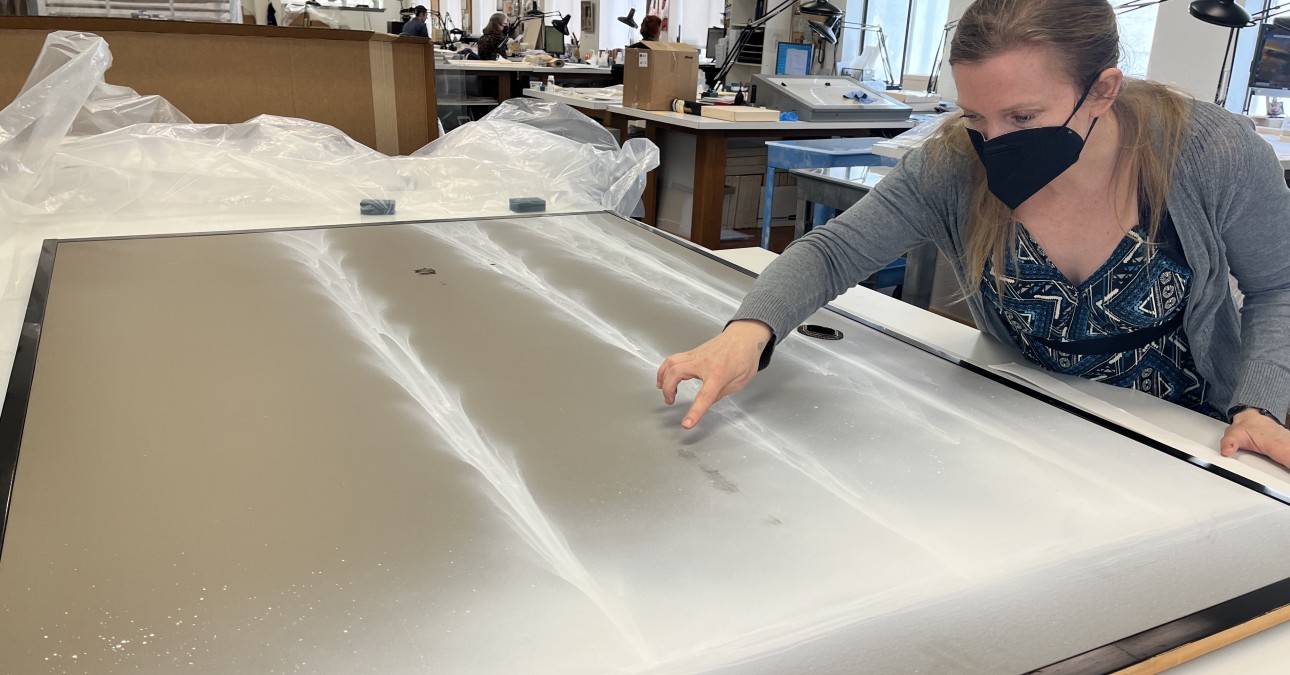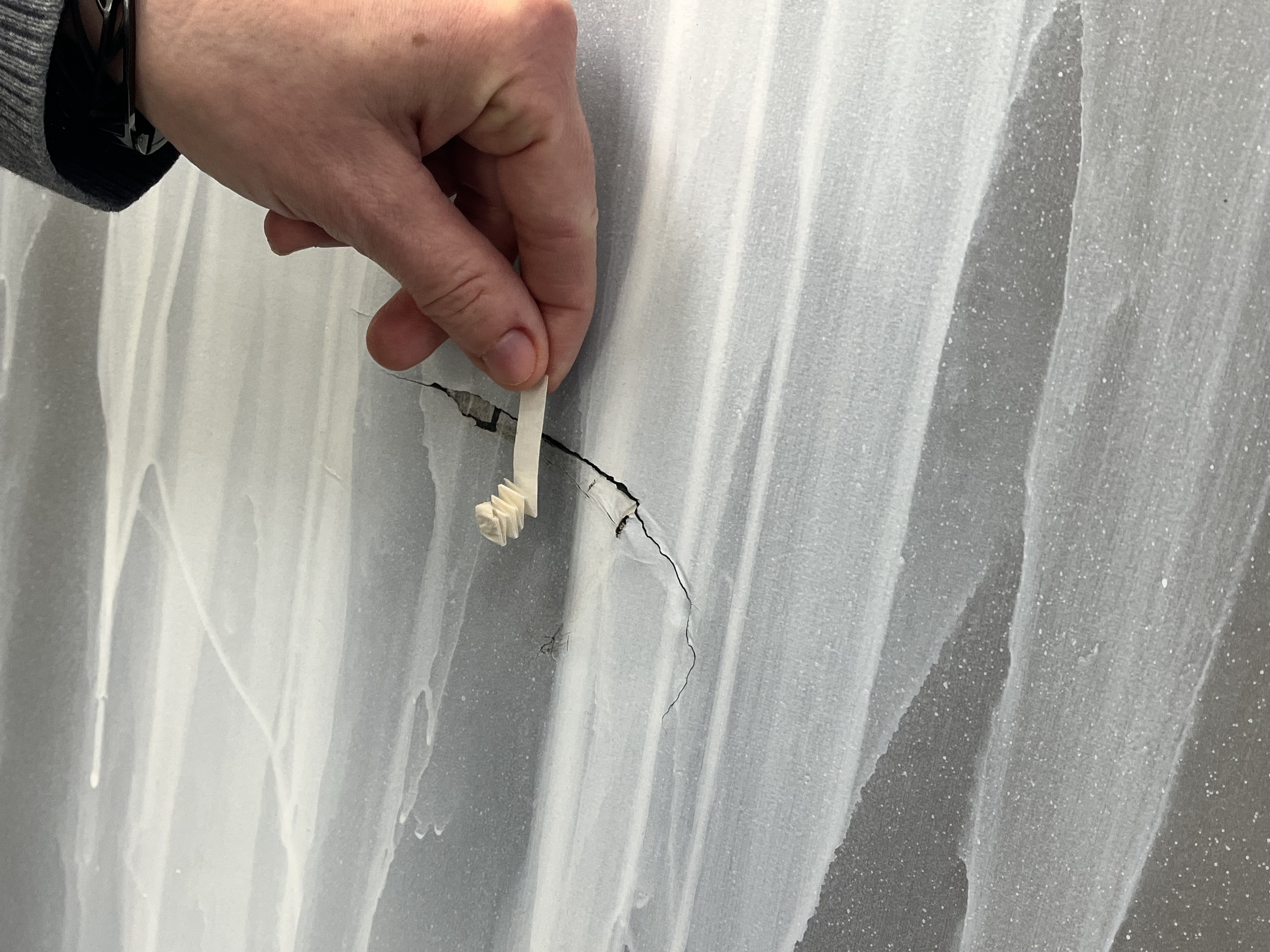
CCAHA's Expertise Helps Client Recover from Act of Vandalism
When employees at Philadelphia's Shofuso Japanese Cultural Center arrived at work on the morning of June 15, 2022, they discovered someone had broken in and damaged the iconic Japanese fusuma murals adorning several interior sliding screen doors.
Caretakers of the Waterfall fusuma documented that two of the ten doors of artist Hiroshi Senju’s creation had sustained damage. But, since the panels were uniquely created for Shofuso in a traditional Japanese painting technique involving numerous layers of paper stretched over a wooden frame, treatment could only be undertaken by specially trained conservators. Enter CCAHA.

After a referral from the Philadelphia Museum of Art, Shofuso connected with CCAHA Senior Paper Conservator Heather Hendry, who evaluated the damage and determined that CCAHA could repair the screens in its Philadelphia lab rather than having the six-by-four-foot panels shipped to Japan.
“It’s a technique we started doing about four or five years ago,” said Heather, “so it’s a relatively new area of expertise for the Center.”
The technique is one Heather and CCAHA co-workers have presented at a conference for the American Institute for Conservation of Historic and Artistic Works (AIC) and published in the Journal of Paper Conservation.
The Art & the Treatment
A traditional Japanese screen has many distinct layers of paper, joined in a variety of methods, over a wooden lattice. Heather said although Senju utilized traditional Japanese methods, he studied Philadelphia’s climate, which is known for large temperature swings, and made sure his art could withstand them. Senju modified the work for Shofuso with a heavier, stronger outer paper chosen to stand up to the local climate.
Those layers of mulberry paper help form the base of the artwork, with the acrylic applied to the surface. The damage to one screen fortunately did not sever any paper layers below the top painted layer. However, one screen suffered a deep puncture wound causing a four-inch gap.

Heather’s job is to fill the gap in such a way that the damage becomes unnoticeable.
On previous screens, she used a layered construction of alternating cross-grained mending strips that create a “floating layer.”
“With the floating layer, I’m working where I can’t actually touch,” said Heather of the delicate nature of the treatment. “I make a little pillow of air where the mulberry paper is then pasted down around the edges.”
“Using that little card that has my mending paper pasted to it, I can sneak the mending paper through the hole until it’s in the right place. I paste the screen edges onto that mend, using traditional wheat starch paste as a flexible and water-responsive adhesive."
In order to get the screen fully flat again she would then humidify the paper with a fine water mist to swell the area. As it dries, the mend holds the tear edges and the tension pulls the paper as it dries and shrinks back into flatness.
However, on this artwork, Mr. Senju chose to use a custom-made acrylic paint, rather than the watercolor typically used on a Japanese screen. He mixed dry pigments into an acrylic Lascaux medium, applying many layers to achieve the ethereal images. This choice was also made to accommodate the Philadelphia climate and make the surface more durable, but it resulted in a paint layer that was more like plastic. That meant that moisture alone could not relax the distortions from the punctures.

Heather first reshaped the dented and twisted paint layer with a thin stream of hot air and a tiny Delrin tool. Small flakes were re-adhered with wheat starch paste. But even when the paint layer was as flat as possible, the punctured area remained indented, so she inserted several mulberry paper springs to gently press the damaged area up into plane. Then she was able to mend the tear edges both from behind, by inserting layered mulberry paper mends, and with strips of gampi paper to smooth the gaps on the front of the tear. This unique evolution of the previous mending technique met the needs of this inimitable artwork.
Careful cleaning of the scuffs and inpainting the mends and areas of paint loss completed the treatment. The treated areas are invisible from a distance but can be found with careful inspection.
Another unique aspect of this project is the dust the screens have acquired over the years. The artist intended the screens to respond to the environment over time, knowing that a layer of dust would collect on the acrylic to form a patina as the object aged.
“The artwork is a living thing as well,” Heather said. “It becomes different over time as the gardens and plants do.”

Since the treatment is focused on only two panels of a larger object, Heather must also consider the entirety of the object when treating. She will need to remove dust and grime, but not too much, so that when the two screens rejoin their companions, there is little to no differentiation in overall color.
Hiroshi Senju, who is well-known for his waterfall paintings, was consulted directly and agreed with CCAHA’s plan. In fact, the artist’s studio has been quite involved and responsive in the process, offering to send pigment samples for in-painting.
“He’s very happy that the screens are being mended,” said Heather.
Shofuso was commissioned as a gift from Japan to the United States as a post-WWII symbol of peace. Japanese architect Junzo Yoshimura designed the traditional Japanese house for an exhibit at the Museum of Modern Art. The house was reassembled in its final home of Philadelphia in 1957. The City of Philadelphia owns the public attraction managed by the Japan America Society of Greater Philadelphia. Mr. Senju’s Waterfall was created in 2007 and has an estimated value of $2 million.
Shofuso Japanese Cultural Center's 2023 Season opens March 22. To learn more, visit japanphilly.org/shofuso.
Photos, from top: CCAHA Senior Paper Conservator Heather Hendry examines one of the mural panels during treatment; Heather reshapes the dented and twisted paint layer with a thin stream of hot air and a tiny Delrin too; a mulberry paper spring used to gently press the damaged area up into plane; carefully cleaning the scuffs; an after-treament reference photo of one panel showing the finished results.